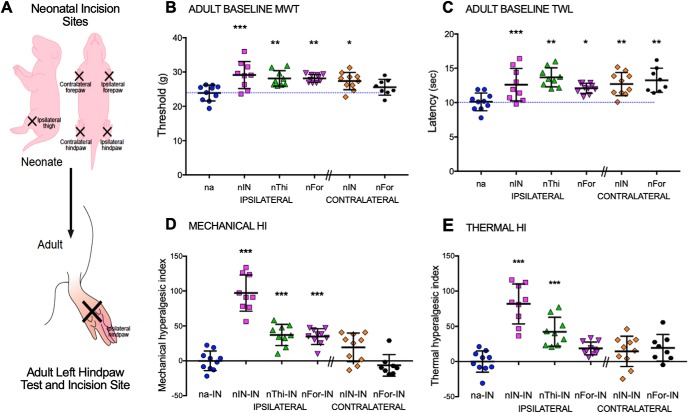Figure 5.
Distribution of baseline hypoalgesia and reincision hyperalgesia in adults differs following neonatal incision. A, The schematic demonstrates different ipsilateral or contralateral incision sites (nIN, hindpaw; nThi, thigh; nFor, forepaw) performed in neonatal (P3) animals, which are followed by incision of the left hindpaw in adulthood. B, Mechanical withdrawal thresholds of the left hindpaw in young adult rats were higher than neonatal anesthesia (na) controls following neonatal incision of the ipsilateral hindpaw (p < 0.001), thigh (p = 0.003), forepaw (nFor p = 0.002), and contralateral hindpaw (p = 0.015). C, Thermal withdrawal latency of the left hindpaw was prolonged following prior incision at all sites (na vs nIN p = 0.006, vs nThi p < 0.001, vs nFor p = 0.033, vs contralateral nIN p = 0.003, vs contralateral nFor p = 0.001). D, Mechanical hyperalgesic index (HI) following adult incision (area over behavioral withdrawal curve vs time to 21 d after incision) was increased by prior ipsilateral incision. E, Thermal HI was similarly increased following prior ipsilateral hindpaw or thigh incision, but not contralateral hindpaw incision. Forepaw incisions did not significantly alter thermal HI. B–E, Data are presented for individual animals (n = 8–10 per group). Bars indicate mean ± SD. ***p < 0.001; **p < 0.01; *p < 0.05; one-way ANOVA with Dunnett's test, compared with neonatal anesthesia (na: B, C) or neonatal anesthesia plus adult incision (na-IN: D, E).

